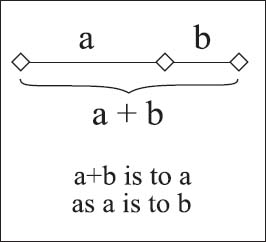Math in EngineeringMathematics and Architecture |
What is the historical significance of the golden ratio? |
It is thought that over the centuries many architects and painters used it in their works. Some historians believe that the Great Pyramid of Cheops contains the golden ratio. The ancient Greeks knew about the golden ratio from their works in geometry, but they never truly believed it was as important as numbers such as pi (π). Many works of art in the Renaissance are thought to have used the golden ratio within paintings and sculptures, although it may have been subconsciously incorporated into their compositions. In 1509 Luca Pacioli published the work Divina Proportione, which explored the mathematics of the golden ratio, along with its use in architectural design.

The idea of the golden ratio is illustrated here by the relationships between a, b, and a + b.
Of course, humans aren’t the only ones who “practice” the golden ratio. It is also seen in nature as the result of the dynamics of some systems. For example, the spacing of sunflower seeds—and even the shape of the chambered nautilus shell—are all often claimed to be related to the golden ratio.

Cutting a nautilus shell in half reveals chambers that follow the rules of the golden ratio. It is a beautiful example of how math can be found all around us in nature.
